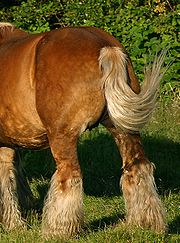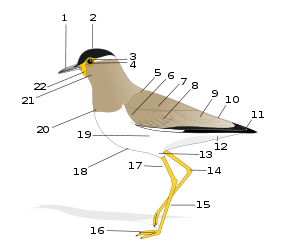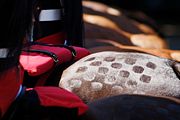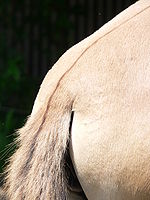
Rump (animal)
Encyclopedia

Morphology (biology)
In biology, morphology is a branch of bioscience dealing with the study of the form and structure of organisms and their specific structural features....
of an animal, is the portion of the posterior dorsum
Dorsum (biology)
In anatomy, the dorsum is the upper side of animals that typically run, fly, or swim in a horizontal position, and the back side of animals that walk upright. In vertebrates the dorsum contains the backbone. The term dorsal refers to anatomical structures that are either situated toward or grow...
that is posterior to the loin
Loin
The loins are the sides between the lower ribs and pelvis, and the lower part of the back. It is often used when describing the anatomy of humans and quadrupeds . The anatomical reference also carries over into the description of cuts of meat from some such animals, eg...
s and anterior to the tail
Tail
The tail is the section at the rear end of an animal's body; in general, the term refers to a distinct, flexible appendage to the torso. It is the part of the body that corresponds roughly to the sacrum and coccyx in mammals, reptiles, and birds...
. Anatomically
Anatomy
Anatomy is a branch of biology and medicine that is the consideration of the structure of living things. It is a general term that includes human anatomy, animal anatomy , and plant anatomy...
, the rump corresponds to the sacrum
Sacrum
In vertebrate anatomy the sacrum is a large, triangular bone at the base of the spine and at the upper and back part of the pelvic cavity, where it is inserted like a wedge between the two hip bones. Its upper part connects with the last lumbar vertebra, and bottom part with the coccyx...
.
The tailhead or dock is the beginning of the tail, where the tail joins the rump. It is known also as the base or root of the tail, and corresponds to the human sacrococcygeal symphysis. In certain mammal
Mammal
Mammals are members of a class of air-breathing vertebrate animals characterised by the possession of endothermy, hair, three middle ear bones, and mammary glands functional in mothers with young...
s the tail may be said to consist of the tailbone (meaning the bony column, muscles, and skin) and the skirt (meaning the long hairs growing from the tailbone). In birds, similarly, the tail consists of tailbone and tailfan (tail fan).

Docking (animal)
Docking is a term for the intentional removal of part of an animal's tail or ears. The term cropping is also used, though more commonly in reference to the cropping of ears, while docking more commonly—but not exclusively—refers to the tail. The term tailing is also commonly used...
, the amputation
Amputation
Amputation is the removal of a body extremity by trauma, prolonged constriction, or surgery. As a surgical measure, it is used to control pain or a disease process in the affected limb, such as malignancy or gangrene. In some cases, it is carried out on individuals as a preventative surgery for...
of the tailbone at or near the dock. These include dog
Dog
The domestic dog is a domesticated form of the gray wolf, a member of the Canidae family of the order Carnivora. The term is used for both feral and pet varieties. The dog may have been the first animal to be domesticated, and has been the most widely kept working, hunting, and companion animal in...
s, cat
Cat
The cat , also known as the domestic cat or housecat to distinguish it from other felids and felines, is a small, usually furry, domesticated, carnivorous mammal that is valued by humans for its companionship and for its ability to hunt vermin and household pests...
s, sheep, pig
Pig
A pig is any of the animals in the genus Sus, within the Suidae family of even-toed ungulates. Pigs include the domestic pig, its ancestor the wild boar, and several other wild relatives...
s, and horse
Horse
The horse is one of two extant subspecies of Equus ferus, or the wild horse. It is a single-hooved mammal belonging to the taxonomic family Equidae. The horse has evolved over the past 45 to 55 million years from a small multi-toed creature into the large, single-toed animal of today...
s. Humans have a remnant tail, the coccyx
Coccyx
The coccyx , commonly referred to as the tailbone, is the final segment of the vertebral column. Comprising three to five separate or fused vertebrae below the sacrum, it is attached to the sacrum by a fibrocartilaginous joint, the sacrococcygeal symphysis, which permits limited movement between...
, and the human equivalent of docking is coccygectomy
Coccygectomy
Coccygectomy is a surgical procedure during which the coccyx, is removed. It can be performed for many reasons for instance in patients with coccyx pain , however it is typically reserved for patients with malignant cancer or for patients whose tailbone pain has failed to respond to nonsurgical...
.
Usage
Usage varies from animal to animal. BirdBird
Birds are feathered, winged, bipedal, endothermic , egg-laying, vertebrate animals. Around 10,000 living species and 188 families makes them the most speciose class of tetrapod vertebrates. They inhabit ecosystems across the globe, from the Arctic to the Antarctic. Extant birds range in size from...
s and cattle
Cattle
Cattle are the most common type of large domesticated ungulates. They are a prominent modern member of the subfamily Bovinae, are the most widespread species of the genus Bos, and are most commonly classified collectively as Bos primigenius...
are said to have a rump and tailhead. Dog
Dog
The domestic dog is a domesticated form of the gray wolf, a member of the Canidae family of the order Carnivora. The term is used for both feral and pet varieties. The dog may have been the first animal to be domesticated, and has been the most widely kept working, hunting, and companion animal in...
s are said to have a rump and dock. Horse
Horse
The horse is one of two extant subspecies of Equus ferus, or the wild horse. It is a single-hooved mammal belonging to the taxonomic family Equidae. The horse has evolved over the past 45 to 55 million years from a small multi-toed creature into the large, single-toed animal of today...
s are said to have a croup (sometimes rump), thigh or haunch, buttock, and dock.

Birds
In bird anatomyBird anatomy
Bird anatomy, or the physiological structure of birds' bodies, shows many unique adaptations, mostly aiding flight. Birds have a light skeletal system and light but powerful musculature which, along with circulatory and respiratory systems capable of very high metabolic rates and oxygen supply,...
, the rump is the body immediately above the tail. The color of plumage on the rump is a characteristic widely used by ornithologists to distinguish between related species, and sometimes also between males and females of the same species. Similarly, the silhouette
Silhouette
A silhouette is the image of a person, an object or scene consisting of the outline and a basically featureless interior, with the silhouetted object usually being black. Although the art form has been popular since the mid-18th century, the term “silhouette” was seldom used until the early decades...
of the tailfan is a characteristic widely used for purposes of identification, particularly in the field.
Some birds have a food reservoir pouch in the esophagus
Esophagus
The esophagus is an organ in vertebrates which consists of a muscular tube through which food passes from the pharynx to the stomach. During swallowing, food passes from the mouth through the pharynx into the esophagus and travels via peristalsis to the stomach...
that is known as a croup
Crop (anatomy)
A crop is a thin-walled expanded portion of the alimentary tract used for the storage of food prior to digestion that is found in many animals, including gastropods, earthworms, leeches, insects, birds, and even some dinosaurs.- Bees :Cropping is used by bees to temporarily store nectar of flowers...
.

Dogs
In some breeds it is traditional for tails to be cut off (docked) at the dock.Horses

In horse anatomy
Horse anatomy
Equine anatomy refers to the gross and microscopic anatomy of horses and other equids, including donkeys, and zebras. While all anatomical features of equids are described in the same terms as for other animals by the International Committee on Veterinary Gross Anatomical Nomenclature in the book...
, the croup refers specifically to the topline
Back (horse)
The back describes the area of horse anatomy where the saddle goes, and in popular usage extends to include the loin or lumbar region behind the thoracic vertebrae that also is crucial to a horse's weight-carrying ability. These two sections of the vertebral column beginning at the withers, the...
of the horse's hindquarters and surrounding musculature, beginning at the hip, extending proximate to the sacral vertebrae
Sacrum
In vertebrate anatomy the sacrum is a large, triangular bone at the base of the spine and at the upper and back part of the pelvic cavity, where it is inserted like a wedge between the two hip bones. Its upper part connects with the last lumbar vertebra, and bottom part with the coccyx...
and stopping at the dock of the tail
Tail (horse)
The tail of the horse and other equines consists of two parts, the dock and the skirt. The dock consists of the muscles and skin covering the coccygeal vertebrae. The term "skirt" refers to the long hairs that fall below the dock...
(where the coccygeal
Coccyx
The coccyx , commonly referred to as the tailbone, is the final segment of the vertebral column. Comprising three to five separate or fused vertebrae below the sacrum, it is attached to the sacrum by a fibrocartilaginous joint, the sacrococcygeal symphysis, which permits limited movement between...
vertebrae begin). Below the croup is the Thigh or Haunch. Behind the thigh is the buttock.
On horse
Horse
The horse is one of two extant subspecies of Equus ferus, or the wild horse. It is a single-hooved mammal belonging to the taxonomic family Equidae. The horse has evolved over the past 45 to 55 million years from a small multi-toed creature into the large, single-toed animal of today...
s appearing in parade
Parade
A parade is a procession of people, usually organized along a street, often in costume, and often accompanied by marching bands, floats or sometimes large balloons. Parades are held for a wide range of reasons, but are usually celebrations of some kind...
s and other public ceremonies, the croup may be decorated with a pattern in the horse's hair, formed by applying hair gel or spray, then brushing patches of hair in opposite directions.

Tail (horse)
The tail of the horse and other equines consists of two parts, the dock and the skirt. The dock consists of the muscles and skin covering the coccygeal vertebrae. The term "skirt" refers to the long hairs that fall below the dock...
minus the skirt (i.e., synonymous with tailbone) Or to the tailhead only. In other equidae, it encompasses most of the tailbone, as most of that portion of the tail does not have long hairs. A lack of long hairs can be natural, as in zebra
Zebra
Zebras are several species of African equids united by their distinctive black and white stripes. Their stripes come in different patterns unique to each individual. They are generally social animals that live in small harems to large herds...
s, donkey
Donkey
The donkey or ass, Equus africanus asinus, is a domesticated member of the Equidae or horse family. The wild ancestor of the donkey is the African Wild Ass, E...
s, and the Przewalski horse, or artificial, the result of pulling, trimming, or shaving part of the skirt (see Horse grooming
Horse grooming
Horse grooming is hygienic care given to a horse, or a process by which the horse's physical appearance is enhanced for horse shows or other types of competition.-Reasons for grooming:...
).
A sponge used to wash the hairless skin on the underside of the dock and other regions under the tail, protected by the dock, is called a dock sponge. Thus, the meaning of "dock" has been used to refer to the orifices beneath the dock, specifically the anus
Anus
The anus is an opening at the opposite end of an animal's digestive tract from the mouth. Its function is to control the expulsion of feces, unwanted semi-solid matter produced during digestion, which, depending on the type of animal, may be one or more of: matter which the animal cannot digest,...
and vagina
Vagina
The vagina is a fibromuscular tubular tract leading from the uterus to the exterior of the body in female placental mammals and marsupials, or to the cloaca in female birds, monotremes, and some reptiles. Female insects and other invertebrates also have a vagina, which is the terminal part of the...
, creating a misapprehension that "dock" refers to the anus, as in, a horse's fundamental orifice is its dock.

